10 of the Best Social Proof Examples From Popular & Growing DTC Brands
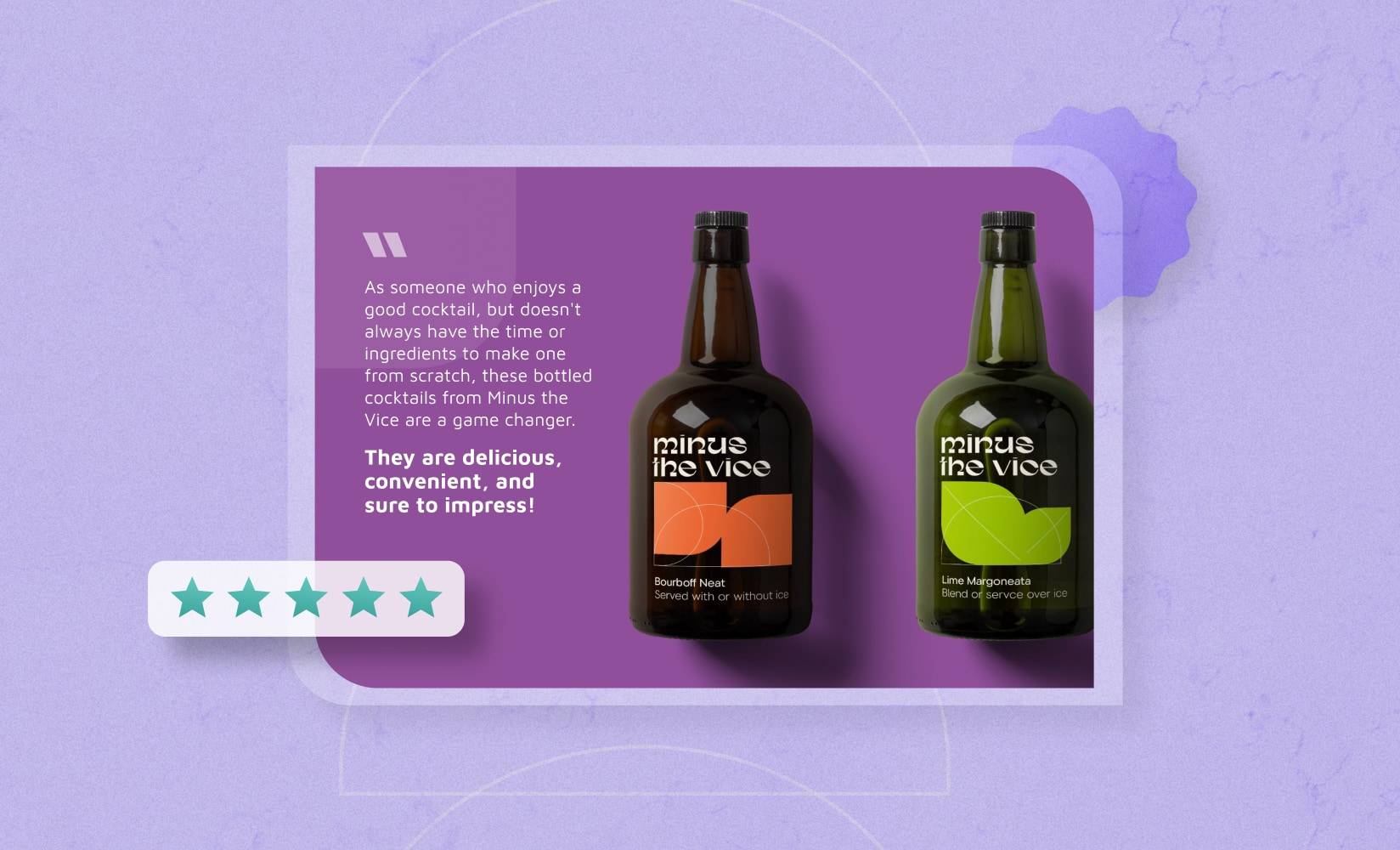
In today’s digital world, anyone can sell anything. People can launch a direct-to-consumer (DTC) website and start dropshipping popular products almost overnight.
But they can’t get others to vouch for their products as quickly.
That’s the foundation of social proof—a type of marketing material that highlights other customers who have been happy with their purchase. It’s a digital stamp of approval, removing your biased branded content and letting your customers do the talking.
So, how do you use social proof to increase your store’s conversion rate?
In this guide, we’ll cover the main types of social proof you can use on your ecommerce website, with 10+ examples of social proof from DTC brands to illustrate each format in action.
- What are the benefits of using social proof in marketing?
- How does social proof influence landing page and store design?
- The main types of social proof used by DTC brands
- Where to use social proof
- 10 social proof examples and case studies from DTC brands
- Social proof FAQs
#cta-visual-pb#<cta-title>Feature your glowing social proof on any page<cta-title>Quickly showcase social proof—like online reviews, Instagram carousels, and quote sliders—with the best page builder for Shopify.Start building for free
What are the benefits of using social proof in marketing?
There are hundreds of ecommerce marketing strategies around. Why should social proof fall to the top of your priority list?
The answer is simple: Social proof builds trust and credibility amongst your target audience.
As Kerrie Fitzgerald, marketing director at Patchwork Pet, says, “Building trust and credibility is the cornerstone of a DTC website. Customers have thousands of choices everyday and if your website isn’t trustworthy, they will likely skip over you and head to Amazon.”
Basing your digital marketing strategy around social proof makes online shoppers feel more confident in choosing you to solve their problems.
If you’re able to prove happy customers have bought your products and enjoyed them, it’s much easier for future customers to remove objections throughout their purchase decision.
“Including social proof on our store, both on the homepage and in its own section, has directly boosted conversions by almost 540% since we implemented this measure nearly three years ago.”
— James Wilkinson, CEO and co-founder of Balance One
How does social proof influence landing page and store design?
While social proof doesn’t need to influence the entire design of your store, it does need to be considered in the wireframing process.
The key is to include social proof in places that draw a customer’s eye—but don’t deter them away from finding important product information.
Shoppers who have difficulty finding key product details are likely to abandon their purchase.
That means including social proof in places like:
- Announcement bars
- Beneath product descriptions
- Inside the image carousel
Heat mapping tools like Hotjar can help identify places to incorporate social proof into your website design. If you see that customers spend the most time reading product descriptions, for example, draw inspiration from Coaltown Coffee’s online store.
The DTC brand uses Shogun to integrate social proof marketing into its website design.
Potential customers see its Great Taste award, B Corporation certification, and 4.9-star Trustpilot rating on the product page, without distracting them from the main product description.
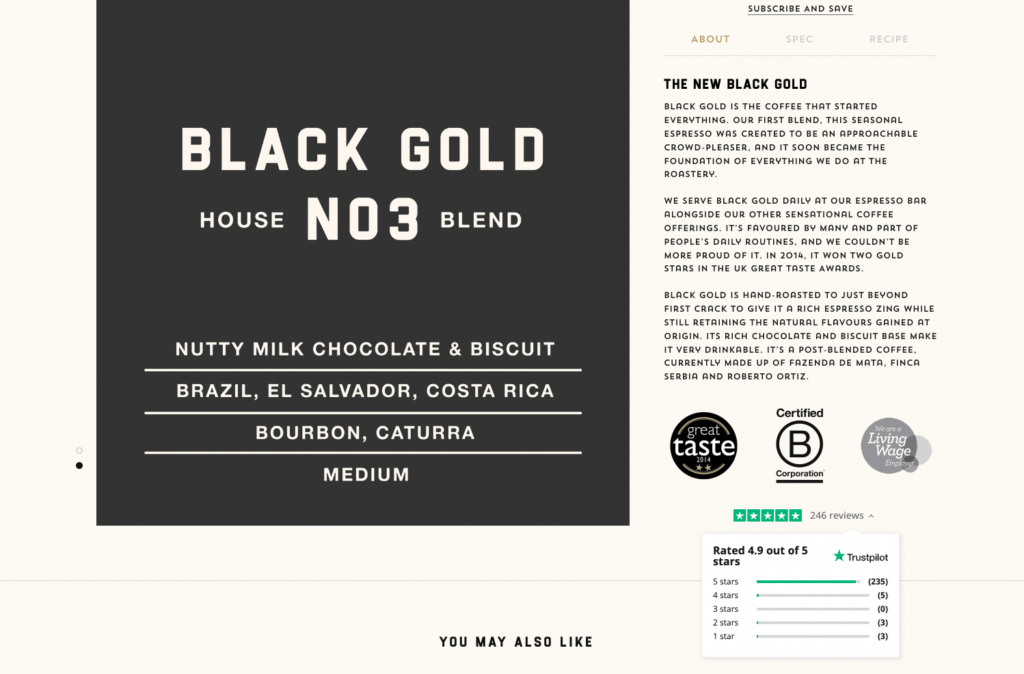
#cta-visual-pb-bes#<cta-title>Make your next promotion convert!<cta-title>Learn how to build persuasive special offer pages from the brands who’ve perfected them. Download the ebook
The main types of social proof used by DTC brands
Now we know the importance of social proof, let’s explore six forms of social proof and how they help ecommerce brands build credibility with potential customers.
- Customer reviews. Almost every online shopper reads reviews left by previous customers before purchasing new products. Types of social proof that fall into this category include testimonials, social media posts, positive reviews, or 5-star ratings.
- User-generated content (UGC). Some 92% of consumers would rather trust another person’s recommendation than branded content. UGC is a type of social proof similar to customer reviews but typically formatted as images or video.
- Industry expert social proof. People with advanced qualifications naturally have more trust with shoppers. If you’re selling children’s supplements, for example, an endorsement from a pediatrician would go a long way in proving your products are credible.
- Influencer or celebrity endorsements. An influencer marketing campaign can get your products a seal of approval using celebrity social proof. More than half of marketers say this type of influencer-endorsed content has a higher ROI than traditional branded content.
- Herd behavior. Herd behavior is a psychological phenomenon in which the actions of others influence our own decisions. Also known as “wisdom of the crowd”, this type of social proof demonstrates how a group of people (most often, peers) have already completed an action—such as viewing a product or sharing it on social media.
- Earned media. Large publications already have a wide circle of influence. Lean on this using social proof from earned media, such as awards, podcast appearances, or news features.
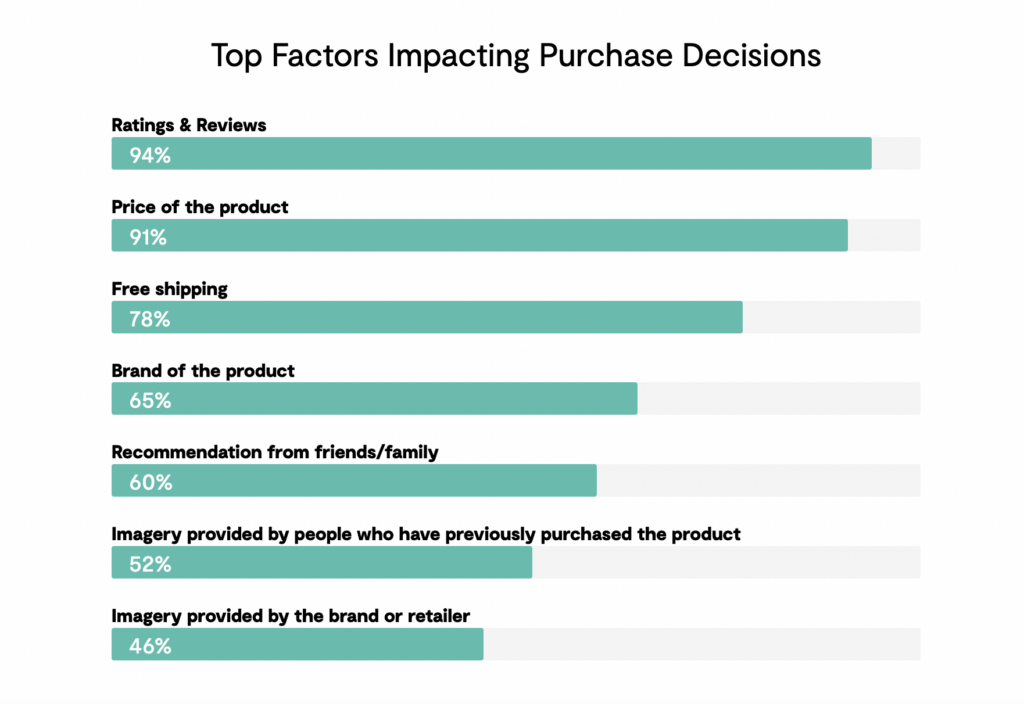
Where to use social proof
Your website’s homepage is often the most visited URL on your ecommerce store.
Make a strong first impression to people visiting your website for the first time with award badges, customer reviews, and celebrity endorsements.
But not everyone visiting your website starts at the homepage. You can sprinkle social proof throughout the customer journey to prime people before they think of purchasing.
That includes:
- Landing and product pages. If someone arrives on your website directly via a landing or product page, reinforce why they should trust you with social proof like product reviews or 5-star ratings.
- The checkout process. Some 18% of online carts are abandoned because the shopper didn’t trust the site with their checkout information. Showcase social proof here to reinforce trust and convince them to complete their purchase.
- Sign-up forms. The simplest way to do this is by detailing how many people are on the list—such as “join 2,000 parents”—which appeals to herd mentality. New visitors want to join the others.
- Advertising campaigns. The average person sees up to 10,000 advertisements per day. Make yours stand out by having other people vouch for you—be that industry experts, influencers, or previous customers.
- Social media. Unsure which type of content to share across social media platforms like Instagram and TikTok? Repost UGC to these profiles and appeal to the quarter of shoppers who think it highlights non-obvious information.
“As for the most effective place to showcase social proof on an ecommerce website, I have found that the product pages are the perfect place. This allows the customer to see what others have said about a specific product and increases the likelihood of them adding it to their cart.”
— Anthony Bautista, founder and CEO of Pure CBD Now
10 social proof examples and case studies from DTC brands
Are you convinced to use social proof to increase sales for your ecommerce brand? Draw inspiration from these examples of DTC brands leveraging different types of social proof to increase sales.
- Nestig
- e.l.f. Cosmetics
- Shelf Expression
- Big Blanket Co
- Santevia
- Kettle & Fire
- Noonbrew
- Crew Clothing
- Bleame
- Lemme
1. Nestig’s reviews and earned media
Nestig is a DTC company that sells children’s furniture through its ecommerce website. It uses Shogun to display various types of social proof on its product pages.
Shoppers browsing its product page are immediately greeted with a 5-star rating.
This is smartly placed above the page’s focal point—the product name—with a standout block color to draw the eye.
Nestig also displays the number of people who’ve submitted their review. It’s much more convincing to see a 5-star review based on 500+ customer opinions than just a handful.

Customers interested in verifying these reviews can click the widget and jump further down the page.
Nestig shows questions asked (and answered) by previous customers, photos of their purchase, and why they’ve chosen their rating.
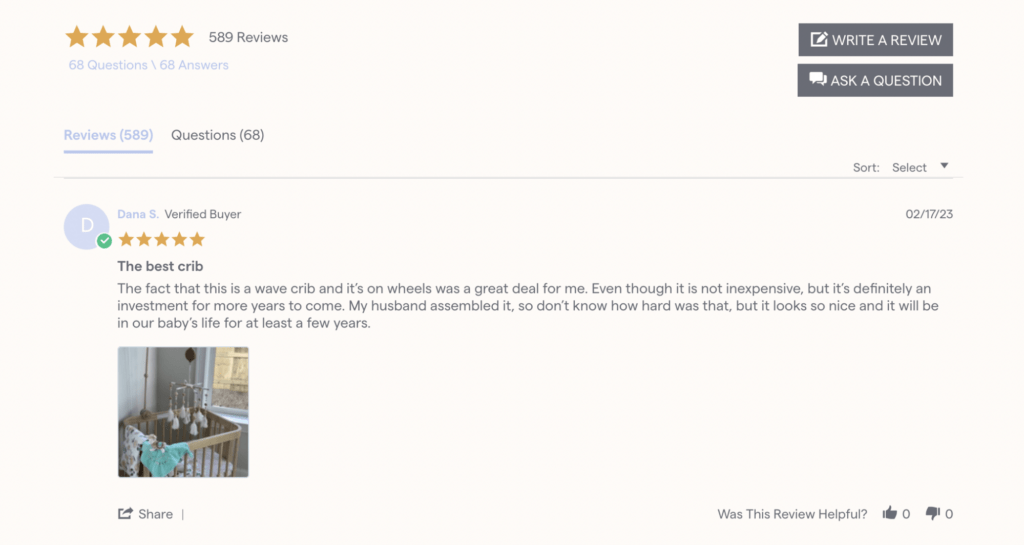
Nestig also uses earned media to reinforce why its children’s nursery products are worth the investment.
It displays quotes from features in Fast Company, Babylist, and What to Expect—three publications its target audience likely already knows, likes, and trusts.

#cta-visual-pb#<cta-title>Your store could look this good<cta-title>Use Shogun to easily add social proof elements—like videos, customer reviews, quote sliders, and Instagram feeds—on any page at scale. Start building for free
2. e.l.f. Cosmetics’ TikTok UGC
TikTok has exploded in recent years. Social media users spend 38 minutes per day on the platform, on average.
And if customers are already talking about your products on the social media platform, you have a wealth of UGC to tap into.
e.l.f. Cosmetics is one brand merging TikTok’s popularity with social proof on its ecommerce website. Its ‘Gone Viral’ campaign places a TikTok-style sticker over product images that have gone viral on the platform.
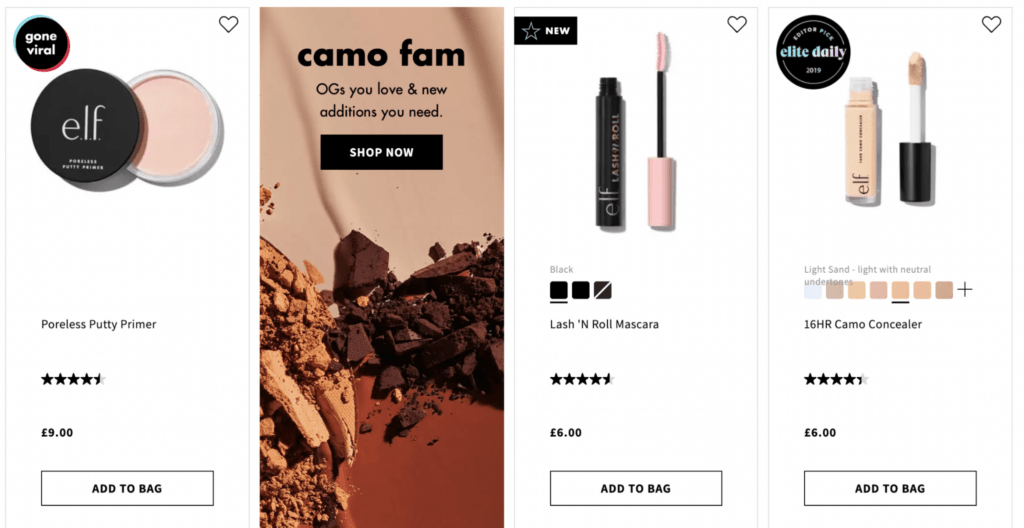
elf Cosmetics’ social proof strategy plays into the “TikTok made me buy it” phenomenon—a collection of videos with more than 7 billion views—to highlight which items are popular amongst users.
We can see this demonstrated again with its TikTok carousel.
Videos using the branded hashtag #elfcosmetics not only show a community around its products but instill a sense of fear of missing out (FOMO).
People visiting the site want to buy elf Cosmetics’ products because they feel like they’re the only ones not doing so.
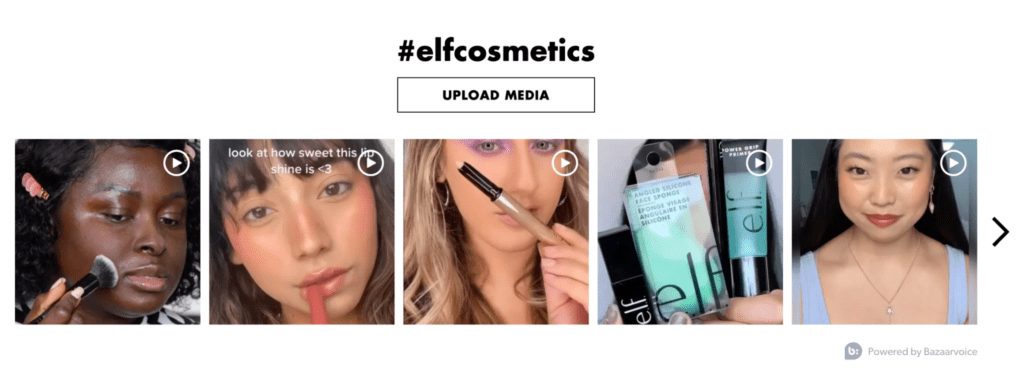
3. Shelf Expression’s customer photos
Shelf Expression sells custom shelving units through its DTC ecommerce store. Its most effective type of social proof? Customer photos.
As CEO Ben Kuhl explains, “Before I added photo reviews to my website, my conversion rate was pretty low at only around 0.7%. I knew that I needed to find a way to provide more social proof to my potential customers in order to build trust and encourage more sales.”
Ben decided to display UGC on their product pages.
After just a few months displaying how previous customers used their shelves at home, the site’s conversion rate almost doubled to 1.3%.
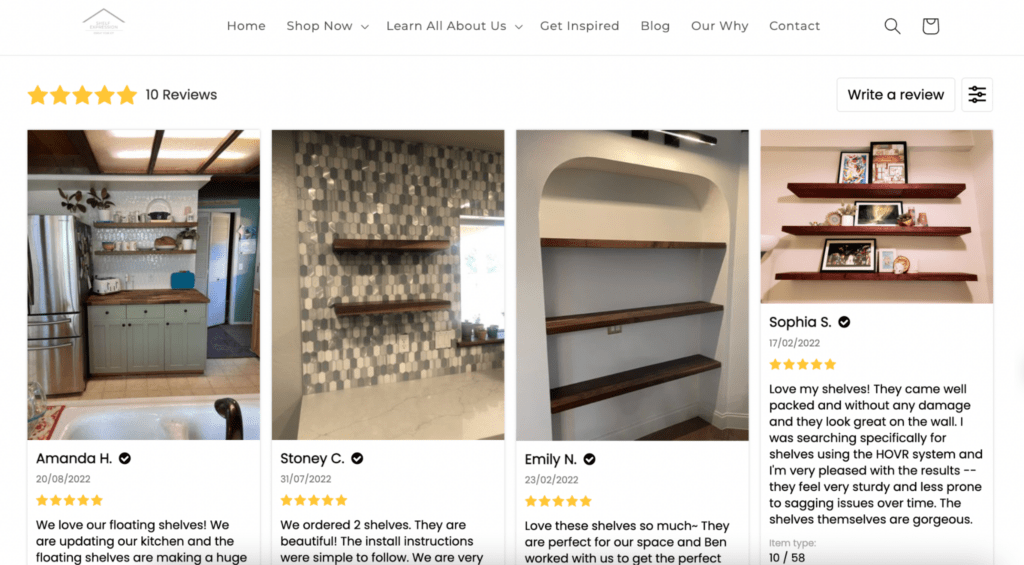
Ben explains, “Using photo reviews really helped me to show potential customers that my business was legitimate and that my products were high-quality.”
“With all the dropshipping happening from overseas these days, it’s more important than ever to prove that your business is real. Adding photo reviews was a simple but effective way to do that, and it really helped to boost my sales.”
4. Big Blanket Co’s earned media
Big Blanket Co sells exactly what the name suggests: oversized blankets.
Product pages on its ecommerce store are littered with social proof, with two strong elements above the fold.
Potential customers don’t have to scroll through its product page to see why they should buy. Big Blanket Co displays a “bestseller” tag over the image carousel.
That sits next to a 4.9-star customer rating and quote from a previous customer, explaining that the product is the “perfect weight that puts me to sleep”.
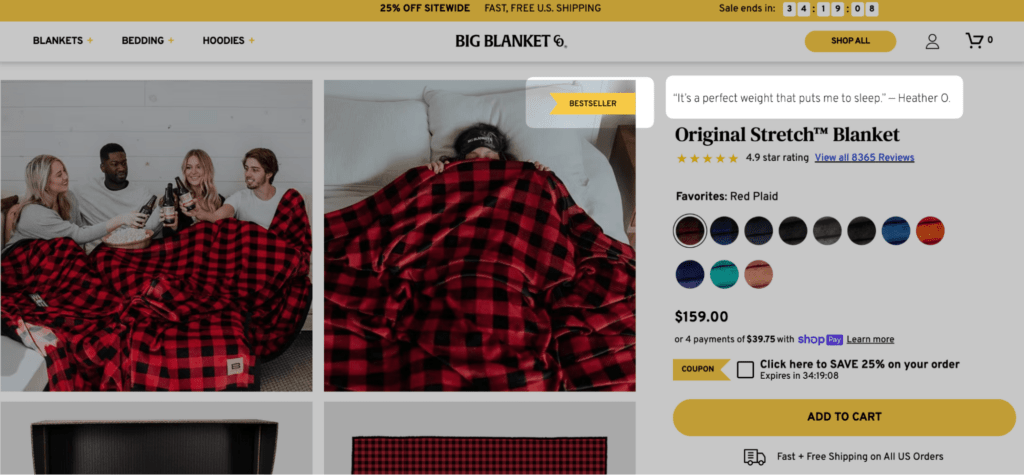
If new customers aren’t yet convinced, Big Blanket Co has a carousel that displays quotes from its press features.
Each quote not only reinforces that the products are of good quality, but that publications its audience already trusts—like House Beautiful, GQ, Yahoo!, and HGTV—have given their seal of approval.

As a final last-ditch attempt to convert customers at the bottom of the page, site visitors see another carousel—this time of images previous customers have shared to Instagram.
It’s designed to instill the feeling that everyone has the product but the person viewing the page.
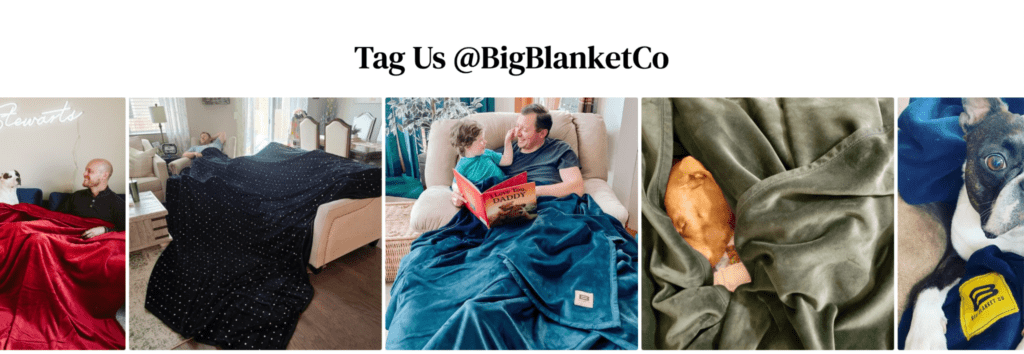
5. Santevia’s expert endorsements
Santevia is a great example of how DTC brands can use social proof without overwhelming website visitors.
Instead of bombarding people with glowing stars and creative videos, it uses Shogun to display a range of customer reviews across each product page.
What’s great about this social proof example is that previous customers talk about the pain points Santevia’s water system has solved.
Whether it’s wanting to look and feel younger, keep their digestive system happy, or simply benefit from better health, new customers can see themselves in their shoes.

#cta-mini-pb#Want to learn more about Page Builder? Learn more
6. Kettle & Fire’s star rating
Kettle & Fire’s social proof strategy hinges on one small (but mighty) element: its 5-star reviews.
People visiting its website for the first time are instantly greeted with powerful social proof. The hero image on its homepage states how its bone broth has more than 30,000 5-star reviews.
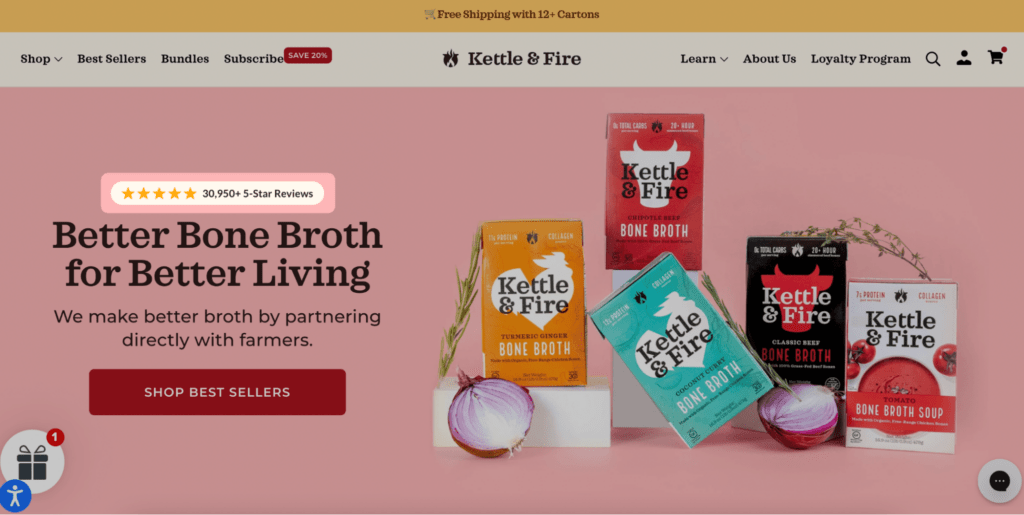
The same star-studded details continue through the customer journey.
When people click through its bestsellers button and arrive on the category page, the star rating for each individual product is visible without forcing them to click through.
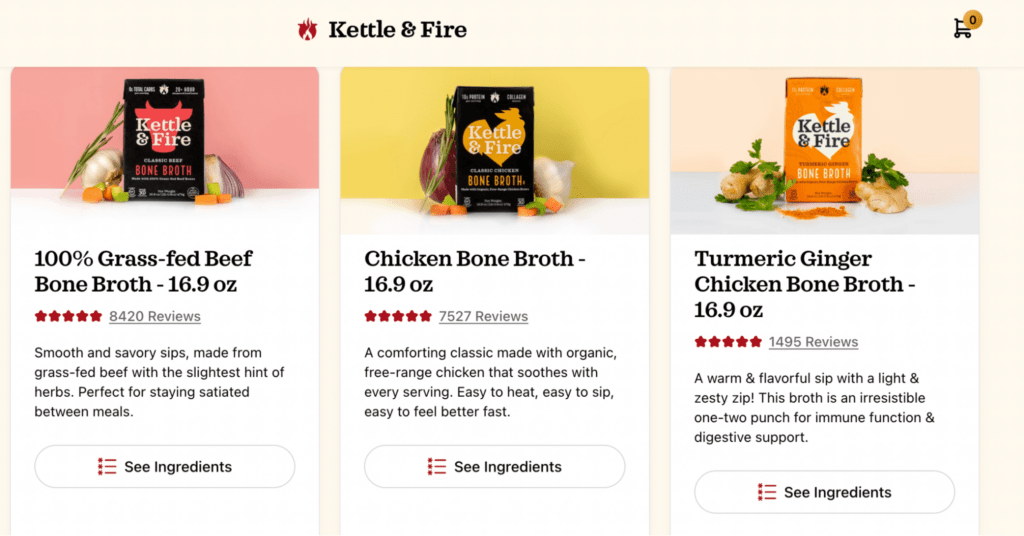
Kettle & Fire also captures people looking for verification that these reviews are real.
Its customer success landing page shares glowing endorsements from influencers its target audience know, like, and trust.
This includes Dr. Sarah Ballantyne, a blogger, bestselling author, and medical doctor—leveraging both influencer and expert social proof simultaneously.
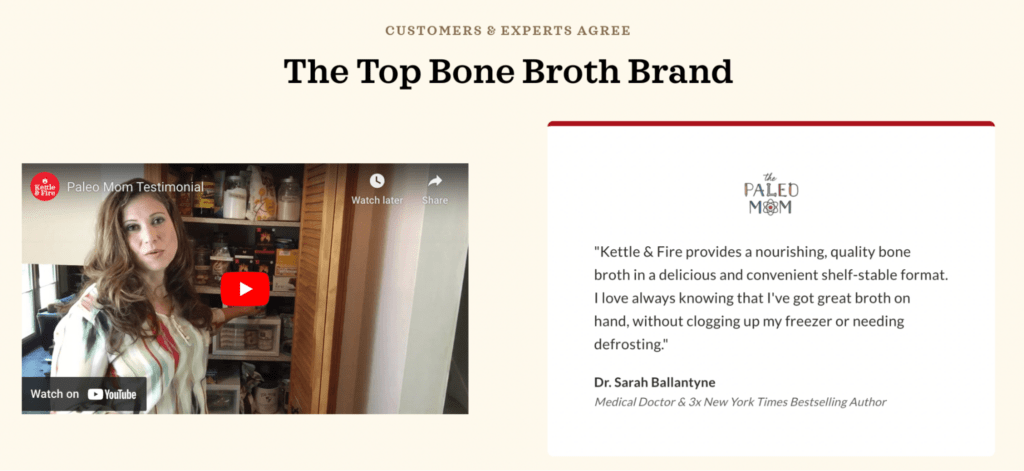
7. NoonBrew’s checkout trust signals
Noonbrew’s DTC website is heavily centered around the use of social proof.
As its CEO and founder Andrew Case explains:
“When someone lands on your website, you have only a few seconds before they decide if it’s worth their time to learn more or they bounce off your website. You need to do everything you can to convince them you’re legit and that they should continue learning more.”
Take its product page as an example. Customers see four types of social proof without needing to scroll down the page:
- The announcement bar showcasing 2,500+ 5-star reviews from 60,000+ customers
- An image sticker which shows its superfood has already sold 5 million servings
- A testimonial from a customer who has seen results in under two weeks
- Its 4.8-star average rating
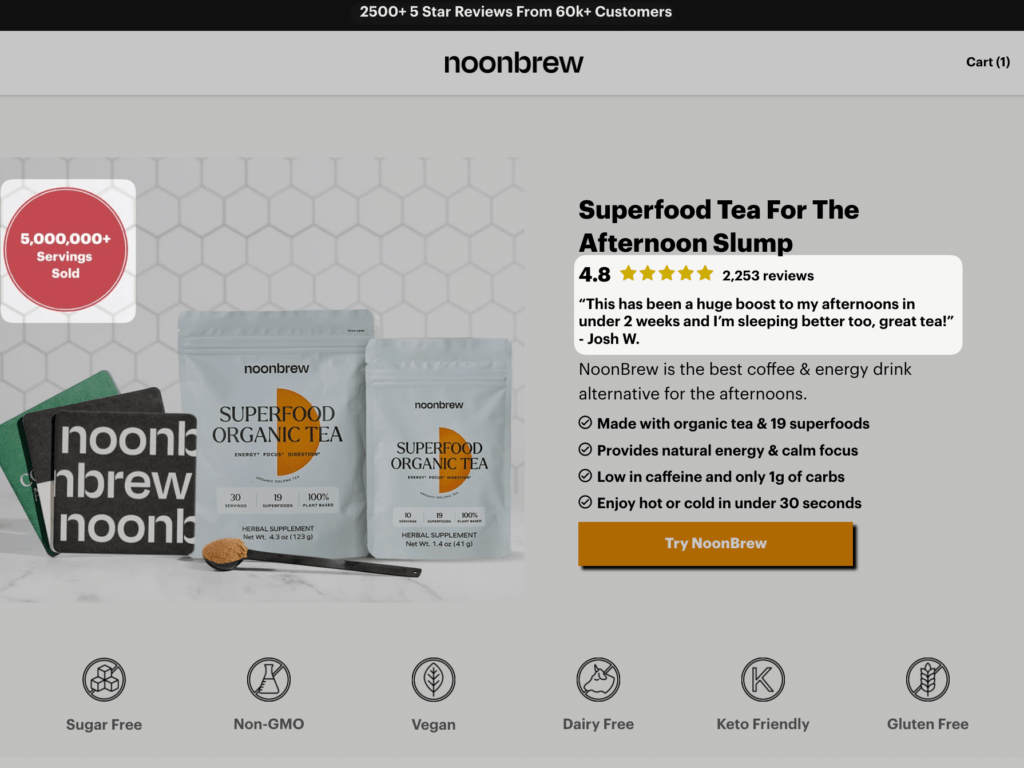
Noonbrew continues its use of social proof at the checkout page.
It reminds the site visitor of how 50,000+ customers have already bought from its DTC store, complete with trust signals to instill further credibility.
It’s these small elements that remove friction throughout the sales process and increase cart conversion rates.
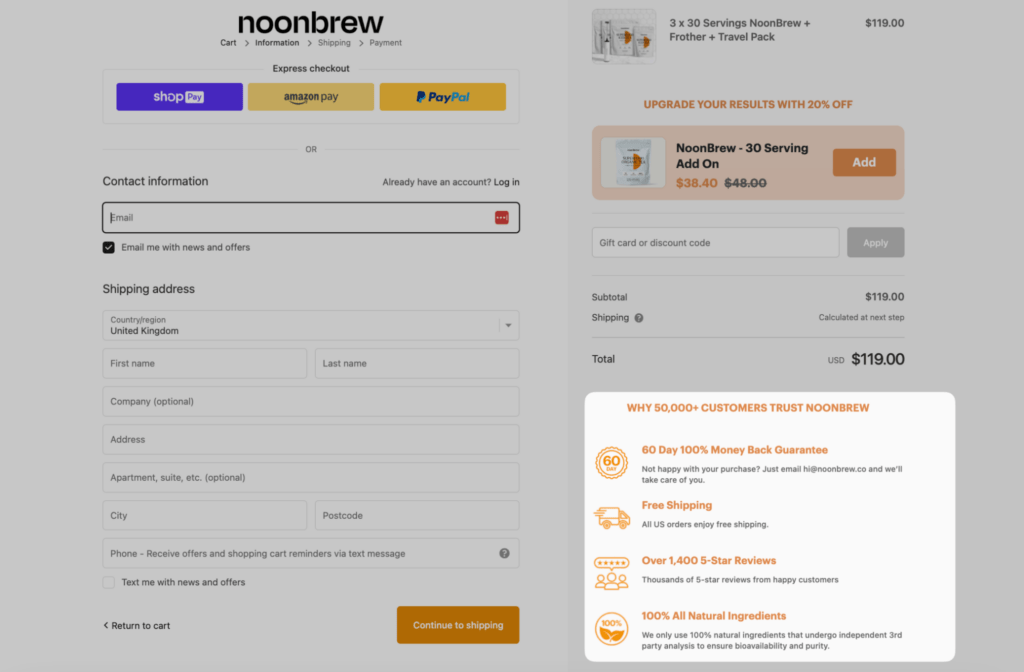
Andrew adds his best advice for DTC brands is to “think outside the box when displaying social proof. The servings sold was something that made us seem a lot bigger than we actually were at the time and one that not a lot of other brands were using.”
“I always advise asking your customers on post-purchase questionnaires what is most important to them and you can ask them what influences their buying decisions,” Andrew says.
“That should highlight different ways to showcase social proof and other indicators to improve conversion rates.”
8. Crew Clothing’s herd behavior pull
Studies have shown that 69% of people experience the fear of missing out (FOMO).
It’s a powerful psychological trigger that, when used correctly, can influence people to buy new products.
Six in 10 millennials have made a reactive purchase, usually within 24 hours, after experiencing FOMO.
Crew Clothing is a UK-based clothing retailer that accelerates FOMO feelings amongst its website visitors. It uses Taggstar to show how many people are currently viewing the product a customer is browsing.

These same messages continue through the checkout process. Once someone has added a product to their shopping cart, they see a small notification that shows the product is “trending”.
It reconfirms the shopper is making the right purchase decision if 60+ others have done the same.

According to Taggstar, Crew Clothing saw a 5.24% conversion rate uplift after implementing this kind of social proof on its DTC ecommerce store.
Its head of digital customer experience Rebecca Leuw said, “Our customers love the extra buying assistance that social proof messaging provides.”
9. Bleame’s TikTok UGC
Bleame is a digitally native DTC brand that sells women’s shaving products through its online store.
Although it operates in a typically boring native (one you’d assume people wouldn’t be forthcoming with glowing testimonials about), Bleame’s homepage has tons of social proof.
Its 175,000 customer reviews and Facebook comment screenshots help build Bleame’s brand reputation.
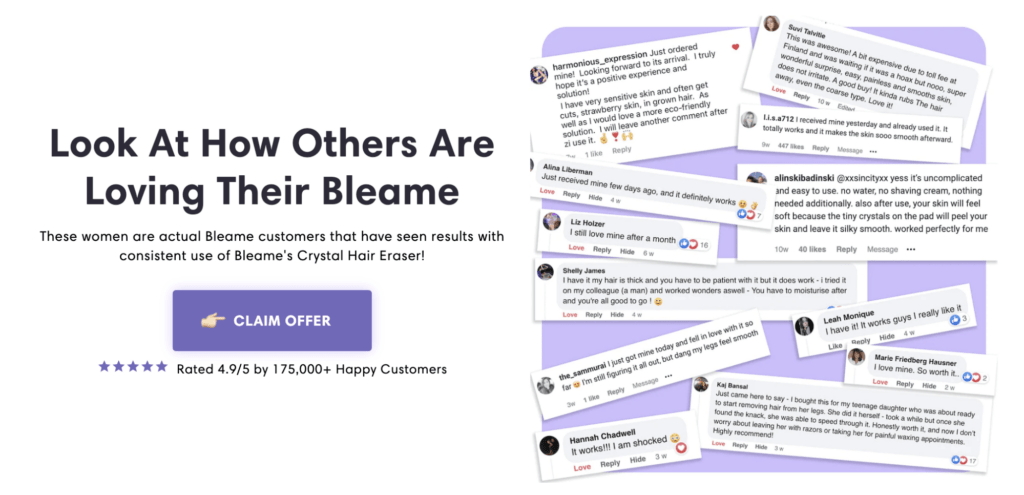
Bleame also uses video testimonials as a form of social proof on its website.
Beneath each product is a carousel of TikTok videos that either demonstrate how to use the product, why the user loves it, and where to buy it from.
And, if the video testimonials weren’t enticing enough, Bleame shows the results of its consumer study beside the carousel.
Each statistic relates to a pain point its target customer is facing, such as “strawberry legs”, ingrown hairs, and skin firmness.
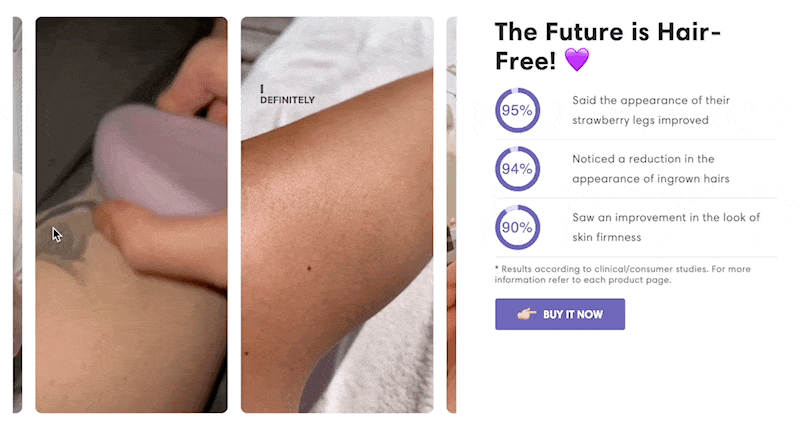
Bleame’s approach to social proof isn’t exclusive to the desktop version of its homepage, either.
Customers who load the website on a mobile device get the same impressive experience—including a sticky “buy now” banner containing 5-star reviews that’s always visible on the screen.
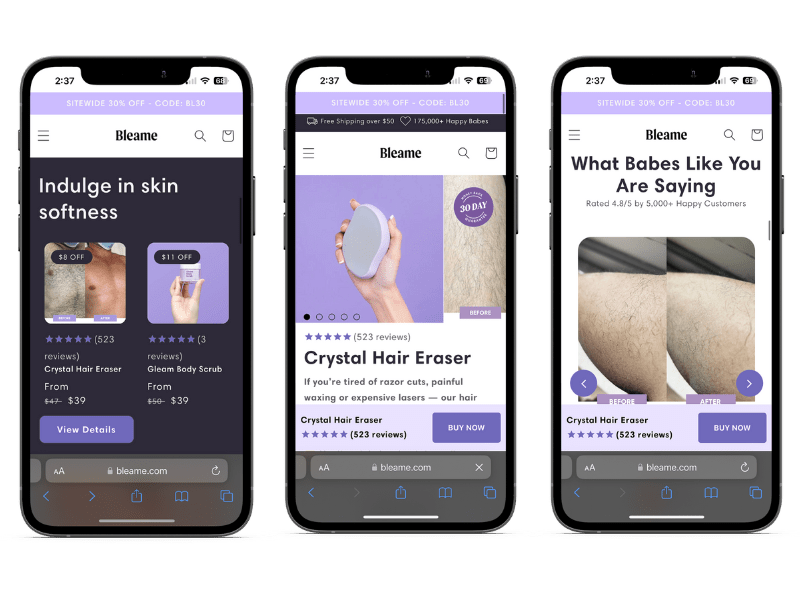
10. Lemme’s customer data
Lemme, the DTC supplements brand founded by mega-influencer Kourtney Kardashian, has social proof baked into its core.
But its ecommerce website doesn’t just rely on Kourtney’s uber-famous name.
Lemme uses a range of elements to build credibility and push website visitors towards making a purchase—starting with its “best seller” stickers on category pages.

Once a site visitor clicks on the product listing, they’re taken to a product page.
Alongside images they’d expect to see (the bottle, capsules, and labeling), there’s a graphic that explains the results previous customers have experienced.
This data is a fantastic way to build credibility and trust without actually contacting your customers. The survey was run by a blind third-party consumer study and goes a long way in proving that Lemme’s vitamins are popular—not a celebrity-fronted dud.
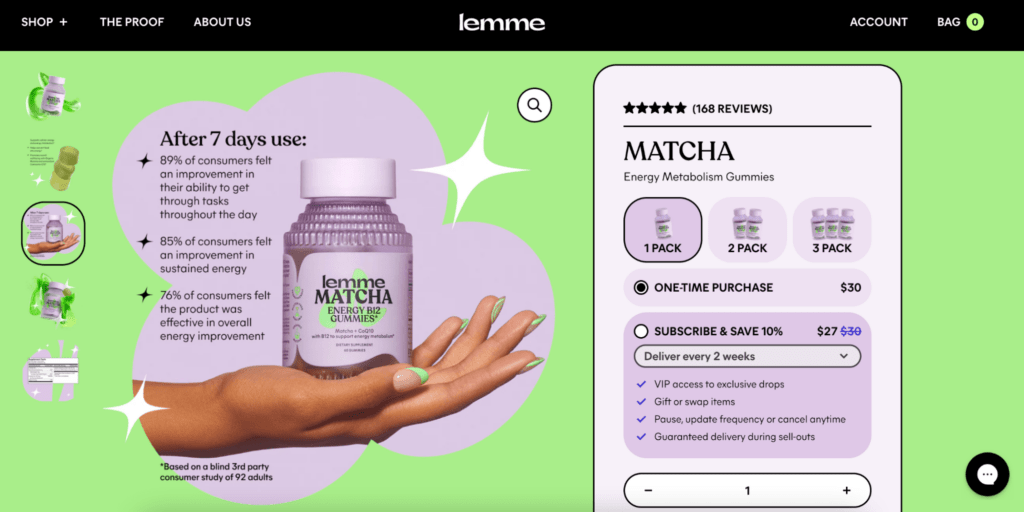
Social proof FAQs
What is meant by social proof?
Social proof is evidence that a person’s peers endorse a product or service.
An ecommerce store might use social proof in the form of customer reviews or influencer endorsements to build credibility and increase conversions.
What are the six types of social proof?
- Expert endorsements
- Customer reviews
- User-generated content
- Social influence
- Herd behavior
- Earned media
What social proof is most popular?
Customer testimonials are the most popular form of social proof. The overwhelming majority (95%) of customers are influenced by reviews from previous shoppers prior to purchasing.
Take note of these social proof examples
Social proof is one of the most valuable tools you can use to convert more customers. And the best part: customers are likely already creating it for you.
Whether it’s Instagram photos using your branded hashtag, endorsements on review sites like Yelp, or influencer collaborations, build your own internal database of social proof.
Experiment with these features across every touchpoint a customer has with your DTC brand to unlock the power of social proof and generate more revenue.
#cta-visual-pb#<cta-title>Build a high-converting DTC store<cta-title>Intuitively display social proof—like online reviews, Instagram carousels, and quote sliders—with the best page builder for Shopify.Start building for free

Elise Dopson
Elise Dopson is a freelance writer for B2B commerce and martech companies. When she's not writing, you'll find her in the Peak Freelance community or on Twitter.



